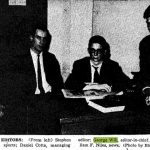MORGAN SULLIVAN ’18
CONTRIBUTING WRITER
I’m sure by now most people have heard of the wildly popular blog “Humans of New York” through links shared on Facebook. You might have perused the stream of captivating photos and charming conversations that inevitably led to not only reading one, but dozens of the photos that have been accumulated through Brandon Stanton’s blog. The original “Humans of New York” was created through somewhat of a failed career path. Originally living in Chicago, Stanton lost his job as a bonds trader and much to his mother’s dismay, took to the streets of New York to pursue his goal of photographing 10,000 people in the city’s neighborhoods. The project quickly expanded and Stanton turned his project into a blog that has become a world-wide photographical project.
This adaptable and geographically transferable idea quickly spread to hosts of other cities around the U.S., many different countries, and various college campuses. The idea eventually made its way to our very own Trinity College, where David Linden ’16 is the second Trinity student to manage “Humans of Trinity College.”
Linden embarked on this project in order to keep “Humans of Trinity College” alive. With the inevitable graduation of Marissa Tornello ’15, the founder of “Humans of Trinity College,” the position had to be filled by someone eager and talented. Tornello and Linden share a passion for photography and stumbled upon the idea that Linden should take over the project. He saw this as a way to fine-tune his photography, step outside of his normal photographic interests, and into the art of portraits.
When I sat down with Linden to talk about his work with “Humans of Trinity,” he shared, “My inspiration for it comes my family, my childhood, and my passion for photography. I went to a small school in New York City where everyone knew everything about everyone. One of the projects we had in first grade was to construct a family tree and I quickly noticed that mine was geographically more diverse from that of my classmates. My parents always taught me that it is important to be able to understand people and treat them equally regardless of their backgrounds. While I attempt to share stories, it is not always easy to tell whether someone likes Humans for the photos or the quotes. Personally, I’m inspired by the photos.”
However, the stunning portraits that Linden captures are not the only aspect of this project, and it is hard to ignore the sometimes lengthy and profound statements that many students make in the captions beside the photos. While for some people who are not well versed in photography, it is often difficult to distinguish the differences between a good photo and a great photo; the anecdote of conversation on the side is an easy way to understand and is universally impactful.
When asked if he thought “Humans of Trinity” was a valuable asset to our campus, he responded, “I don’t know if it is necessarily a valuable asset. I’d hope people just have a strong interest in it, whether they are browsing through it when they’re going to bed or whenever. People have a repertoire of things they like on the Internet: results of sports, Facebook, Instagram, whatever, and now hopefully Humans! Despite the blog being accessible to the entire community, at the end of day, what matters most to me is that the individual featured is happy.”
Linden’s approach to what he does with this project differs from some others’ perspectives. He said, “One person told me I’m incredibly influential. Unlikely, but if that’s what they think, I have no problem with that.”
I retorted, “If someone’s telling you you’re influential, you’re obviously influencing someone.”
“And I think that’s absolutely wonderful, and it makes me very happy that they think that. I try to help people in any way I can.”
However, being considered an inspiration comes with its challenges. Linden tells us, “I think one of the more challenging aspects of the project is the best way to ask certain questions. The challenges are asking the necessary questions in order to elicit responses that I am looking for and being able to tell someone else’s story. It is not always easy getting people to talk about their experiences.”
I was able to encounter first-hand how he acquires such in depth and reflective responses from people. He starts with a series of basic questions such as, “How have you enjoyed your experience at Trinity?” and as the conversation progresses, more personalized questions are asked and Linden is able to uncover statements that are at the root of what makes a person who they are. A perfect example was when I was talking to Linden and the questions started at surface level, but as the conversation progressed, his questions became tailored to my responses and I eventually told him that it is important to be happy. He responded by asking, “What makes you happy?”
Being caught up in regular life it is easy to neglect some of the more important questions. College isn’t solely about academics, sports, and parties. It is four years between childhood and adulthood that allow you to explore the world around you and figure out your own personal values. Through the direct and meaningful questions that Linden asks for his “Humans of Trinity” site, people are “hopefully better able to understand their own values.”
In his closing remarks about his work with “Humans of Trinity College,” Linden says, “The whole point of Humans of Trinity College is to find out exactly what it is that individuals care about, what they struggle with, and to show that despite the fact that we are all different and do different things during our days, we all care about similar things and go through similar experiences…what I love about it is to be able to show the whole community a little piece about somebody’s life that makes up who they are.”
Wednesday, January 15 2025
The Student Newspaper at Trinity College in Hartford, Connecticut



+ There are no comments
Add yours